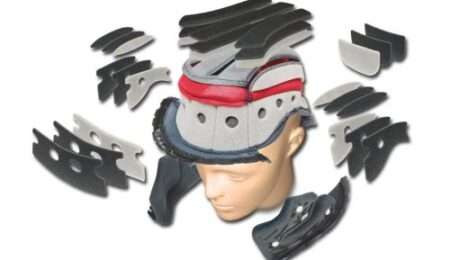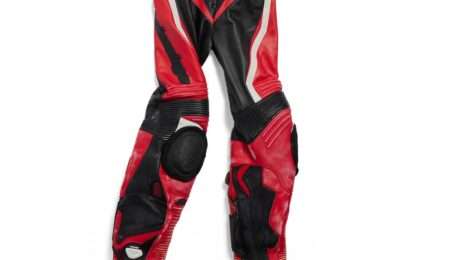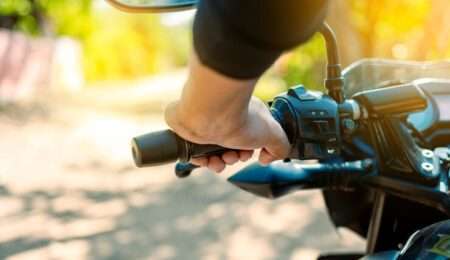Chain, Tires, Battery, Lighting, Preventive Maintenance…
10 Tips To Keep Your Motorcycle Running Safely All Winter Long
In winter, for the biker, it sucks. So there are two options: put your bike in a shelter and for that, we ‘ll present you another article on bi3bike blog for a good wintering. Or ride, because you have no choice, or because it fits your lifestyle.
Here are all our maintenance tips so that your machine is resistant to cold, rain, salt and that it works for you in all circumstances…
1. Battery

To ride, your motorcycle must already start. However, no luck: the batteries hate the cold and if your machine sleeps outside, the energy necessary to launch the engine room may end up lacking on a chilly morning. A battery tends to do better if it is used regularly (don’t expect miracles when restarting after three or four weeks of extreme cold) and it may be wise to recharge it regularly. However, their life is not forever and if you absolutely need to leave it at a fixed time, investing in a booster (there are very compact models these days like the Minibatt ST12, which weighs less than 500 grams) can allow you to start and honor your appointments. And to learn more about battery technology, click here!
2. Don’t forget fluids
Again, two scenarios: you have a liquid-cooled machine. In this case, check the coolant level and, if necessary, top up with antifreeze. Remember this essential point, because an old coolant loses its anti-freeze and anti-corrosion properties; however, we sometimes tend to ignore its replacement during revisions. In the case of an air or air/oil cooled machine, choosing a lubricant with a lower viscosity will facilitate cold starting. Viscosity is the X of the X-W-YY index (genus 5W40) which characterizes each oil. And the same rule applies as for the coolant: an old oil loses its qualities. When was the last time you drained?
3. Safety: tires

Once the machine has started, you can drive. And what are we riding on? On tires, of course! Many riders tend to do a service in the spring, put new tires on for the summer, and then finish them off in the winter. Error, because it is in fact the opposite that must be done: it is precisely in conditions of low grip that you need the tires in the best possible condition so that the rubber and the carcass can work in difficult conditions. Optimum conditions, which consists in particular in ensuring that the grooves can do their job of evacuation. You should also know that sports tires have difficulty heating up in winter and that more road tires, suitable for rain, will be more appropriate. We can also increase the pressure a little to precisely widen the grooves. For scooters, some manufacturers offer winter tires also called 4 seasons like Michelin Citygrip winter with Metzeler Wintec.
4. Safety again: lighting

When riding, sight is life, said an old Road Safety advertisement. And on the handlebars, even more, because you not only have to see, but also be seen. So check the lighting of your headlights as well as the adjustments and the range of the beam. Do not hesitate to mount a high-performance bulb, within the limits of what your alternator can support and what is legal. If you drive in areas heavily impacted by fog, fitting a rear fog lamp and additional LEDs at the front may be a plus. Don’t forget either that small turn signals, tiny or covered with smoked glass, that you have unearthed as an accessory, may give your frame a “cool” look, but it makes you even less visible. Now, what did we say at the beginning? View is life!
5. Security: brakes
Winter is not the ideal season for increasing trappers’ braking. Between the front tire which does not heat up, the big gloves which give you the same sensitivity on the controls as, in the past. Because in winter, a lot of crap come to nest in the most unlikely places on your bike and you will recognize that the brake calipers are particularly exposed. Regular dismantling and cleaning to remove salt and other dirt will ensure their proper functioning. There are special cleaning bombs for discs in particular (necessarily not greasy).
6. Oil it up!

The wiring harness can suffer from excess moisture, as can some spark plug caps. Some motorcycles are very sensitive to this, like the Suzukis of the 90s. Applying a silicone spray as a preventive measure can save you a lot of problems. In the same logic, we will also think of protecting very simple elements, but particularly exposed and which can become immobilizing: the side stand switch, for example.
7. Lubricate the chain

Do you have a gimbal motorbike? Happy for you. Do you have a channel? There, it is more complicated, because obviously, the chain is particularly exposed to salt and various projections. It will therefore be necessary to pay careful attention to it, whether for lubrication which must be more intensive; the other side of the coin, with more grease, the chain will aggregate dirt which will eventually turn into a kind of disgusting abrasive paste. It is preferable to use a grease designed for off-road use than a grease for the road that is often thicker. But you have to give it more often. It will therefore be necessary to think about cleaning the chain from time to time. For those who ride really a lot in this season, installing an automatic lubricant kit (Scottoiler or Cameleon Oiler style) may be wise.
8. Exhaust pipe
The exhaust is one of the most exposed parts and one of the most difficult to protect. Resist the temptation to put a protective grease, since it will cook over the exhaust with a smell. So apart from the all-stainless exhaust, there is no miracle solution other than tip number 9, yes. Check it out below.
9. Washing, rinsing, spinning

Even more than in summer, regular washing of your machine is essential. Contrary to popular belief, do not favor hot water: it amplifies the corrosive effects. On the other hand, a sponge and soap finish is desirable: this eliminates the salt and this will allow you to track down possible leaks and weaknesses. Some anticipate the damage of salt on sensitive parts, such as the fork tubes, by covering them with a resistant plastic film. It stands.
10. Protect your motorbike
If your machine sleeps outside or in a freezing and open garage, having it sleep under a protective tarp can be a good idea. Warning: do not put the protection on a hot machine, which has just been driven. This would develop phenomena of condensation and residual humidity. By following these few tips, your motorbike should serve you well all winter long. Don’t forget to follow your local safety road.





